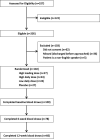Bone turnover markers as surrogates of fracture healing after intramedullary fixation of tibia and femur fractures
- PMID: 35442058
- PMCID: PMC9057525
- DOI: 10.1302/2046-3758.114.BJR-2021-0226.R1
Bone turnover markers as surrogates of fracture healing after intramedullary fixation of tibia and femur fractures
Abstract
Aims: Bone turnover markers (BTMs) follow distinct trends after fractures and limited evidence suggests differential levels in BTMs in patients with delayed healing. The effect of vitamin D, and other factors that influence BTMs and fracture healing, is important to elucidate the use of BTMs as surrogates of fracture healing. We sought to determine whether BTMs can be used as early markers of delayed fracture healing, and the effect of vitamin D on BTM response after fracture.
Methods: A total of 102 participants aged 18 to 50 years (median 28 years (interquartile range 23 to 35)), receiving an intramedullary nail for a tibial or femoral shaft fracture, were enrolled in a randomized controlled trial comparing vitamin D3 supplementation to placebo. Serum C-terminal telopeptide of type I collagen (CTX; bone resorption marker) and N-terminal propeptide of type I procollagen (P1NP; bone formation marker) were measured at baseline, six weeks, and 12 weeks post-injury. Clinical and radiological fracture healing was assessed at three months.
Results: CTX and P1NP concentrations peaked at six weeks in all groups. Elevated six-week CTX and P1NP were associated with radiological healing at 12 weeks post-injury (odds ratio (OR) 10.5; 95% confidence interval 2.71 to 53.5, p = 0.002). We found no association between CTX or P1NP and functional healing. Baseline serum 25(OH)D showed a weak inverse relationship with P1NP (p = 0.036) and CTX (p = 0.221) at 12 weeks, but we observed no association between vitamin D supplementation and either BTM.
Conclusion: Given the association between six-week BTM concentrations and three-month radiological fracture healing, CTX and P1NP appear to be potential surrogate markers of fracture healing. Cite this article: Bone Joint Res 2022;11(4):239-250.
Keywords: Bone turnover marker; Bone turnover markers; CTX; Fracture; P1NP; Serum; Vitamin D; femoral shaft fractures; femur fractures; fracture healing; randomized controlled trial; tibia; type I collagen.
Figures






